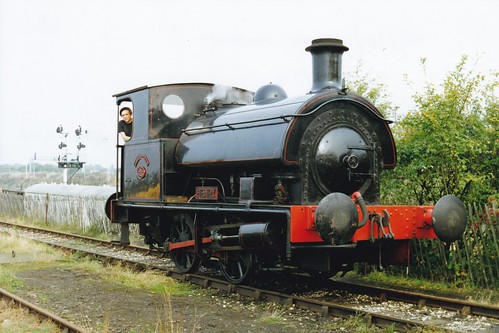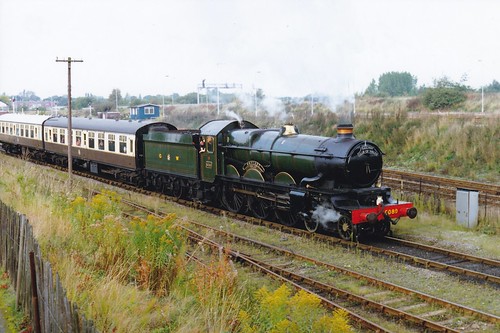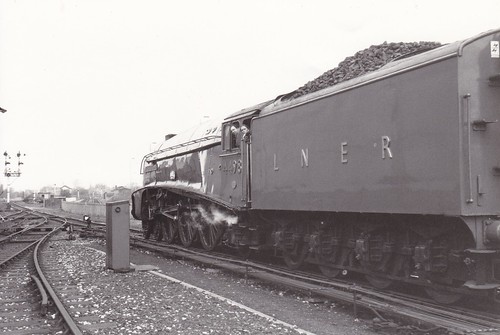1. Mandatory safety briefing.
2. The Shunter (person on the ground marshalling vehicles).
3. Signalling (using the Museum's working signal box).
4. Locomotive engineering (using locomotives under repair/restoration).
5. Driving and firing a small tank engine.
6. Driving and firing a well-known tender engine.

'Henry' often served as the small tank engine.

Initially, 5080 'Defiant' was the tender engine (here shown on a passenger train on a Gala Day on 9-Oct-1994).
The trainees were divided into groups of 3 on the footplate, with an Instructor Driver (who in addition to supervising the trainees was responsible for firing/boiler management). For the non-footplate sessions, two footplate groups were usually combined so museum volunteers gave talks to groups of 6 or more trainees and, if 'friends and family' chose to join these sessions, parties of 12 or more were common!
The Shunter's session looked at static wagons, examined manual and vacuum braking systems and demonstrated the use of the Shunting Pole and Brake Stick. Some trainees were keen to try for themselves. Some of the things we explained on these sessions are described in this blog in posts titled 'The Role of the Shunter', starting here.
In the signal box, apart from looking at the mechanical and electrical equipment in the locking room of the signal box, the operating floor gave opportunities for trainees to work the lever frame.
The Locomotive Engineering session conducted in the workshops and outside around the yard with various dismantled locomotives allowed close-up views of different parts of locomotives, including wheelsets, frames, cylinders, motion and boilers. The talks were a very simplified version of the syllabus being covered in Mutual Improvement Classes (MIC) for volunteers at Birmingham Railway Museum being run at the same time, in which I was involved. The background to MIC courses is described in the post here and there's an index of posts in this blog which have the kind of technical content covered in MIC Classes here.
Although the driving sessions were what people had come for, I was surprised and gratified at how much serious interest was shown in the shunting, signalling and locomotive engineering sessions, by both trainees and friends and family'.
Other locomotives were made available to drive from time to time, so the 'small tank engine' role was fulfilled variously by Avonside 'Cadbury No. 1', Bagnall 'Victor' and at least two Tyseley Panniers. A constellation of tender engines included:-
7029 'Clun Castle'
6024 'King Edward I
4920 'Dumbleton Hall'
45593 'Kolhapur'
6203 'Princess Margaret Rose'
34027 'Taw Valley'
35005 'Canadian Pacific'
4498 'Nigel Gresley'
 Birmingham Railway Museum: Jan instructing on streamlined A4 4498 'Nigel Gresley'.
Birmingham Railway Museum: Jan instructing on streamlined A4 4498 'Nigel Gresley'.
Remarkably the iconic Gresley A3 4472 'Flying Scotsman' also made a number of visits offering driving experiences - there's a post about 'Flying Scotsman' at Birmingham Railway Museum here.
Related Posts on this Website
Birmingham Railway Museum, Tyseley.
'Flying Scotsman' at Birmingham Railway Museum.
Index of MIC-related posts.
My Pictures
Where necessary, clicking on an image above will display an 'uncropped' view or, alternately, pictures may be selected, viewed or downloaded, in various sizes, from the album listed:-
Birmingham Railway Museum.
Tyseley 100.
